USS MULLINNIX DD-944
30 March 1972
Countering The Easter Offensive

In the months before Easter 1972, the Communist buildup had been noted, but Washington and Saigon underestimated the scope, magnitude, and character of the coming attack. Thus, the North Vietnamese achieved considerable tactical surprise. Hanoi’s invading forces thrust into three of South Vietnam’s four military regions.
By February 1972, the North Vietnamese had positioned thirteen divisions for a spring offensive into the south. Timing this to coincide with the monsoon season severely restricted U.S. air power due to weather conditions, Friendly ground forces met for the first time with a North Vietnamese force equipped with many first-line Soviet weapons, including a number of new tanks, heavy artillery pieces, anti-aircraft missiles, and anti-tank missiles.
At the beginning of March 1972, the war in South Vietnam was in a lull. Although guerrillas still harassed some areas and North Vietnamese regiments remained active in a few border areas. Estimates stated that 97% of the settled areas in South Vietnam were either "totally or relatively secure." This "calm" proved illusionary. North Vietnamese Defense Minister General Vo Nguyen Giap was planning a massive invasion designed to destroy and capture South Vietnam.
As increased evidence of an incipient North Vietnamese offensive was being gathered and as the Paris Peace Talks were stalemated, the United States broke off the negotiations on 23 March 1972. By then, North Vietnam’s patient and practical leaders had for several years observed the steady decline in American strength in the South. Then, on Good Friday, 30 March 1972, the Communists struck; launching a series of military drives collectively known as the “Easter Offensive”.
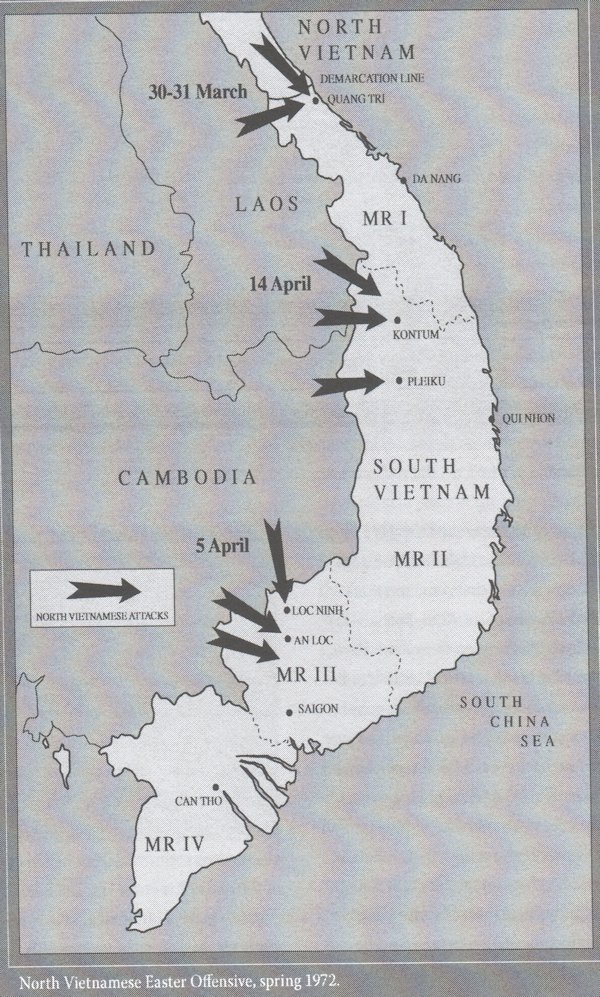
At the time, South Vietnam was divided into four military regions: MR I was the northern section along the DMZ; MR II was the Central Highlands; MR III was the area between Saigon and the Central Highlands; and MR IV was the Mekong Delta south of Saigon. Giap's plan called for a major thrust across the DMZ, while other forces moved in from the A Shau Valley in the west. The goal was to make South Vietnam commit its forces to defend MR I, while the North would launch a second attack from Cambodia towards Saigon in MR III. A third assault would hit the Central Highlands (MR II) and attempt to cut the country in half. These attacks were designed for a total collapse of South Vietnam or a peace treaty very favorable to Hanoi.
The Easter Offensive was a massive conventional attack. The north committed 14 regular divisions, 26 regiments, and a massive amount of supporting armor – more than 600 T-54, T-55, and the amphibious PT-76 tanks. The North Vietnamese ground forces also were fully equipment with artillery, including the dangerous and effective 130-mm and 152 mm artillery pieces and huge 160-mm mortars.
Even so, the key element of Giap’s (Defense Minister Vo Nguyen Giap), arsenal was a vastly expanded anti aircraft system that traveled along with invading forces. The flak weapons included 23, 37, 57, 85, and 100-mm guns. Supplementing the familiar SA-2 surface-to-air missiles were deadly man-portable SA-7 Strela heat-seeking missiles, for which totally new tactics had to be devised.
The Easter Day invasion was the North’s version of Hitler’s blitzkrieg – ‘lightening war’ – a massive attack, speedy, multi-front, overwhelming…heavy armor, multiple divisions and a continuous supply chain that stretch beyond the reach of the existing assets of the US Navy and Air Force. At noon on Good Friday, 30 March, the 308th NVA Division plus two independent regiments struck the ARVN fire support bases along the DMZ. From the west, the NVA's 304th Division moved out of Laos attacking past Khe Sanh toward Quang Tri City. The ARVN's 3rd Division was quickly overran, leaving the road to Quang Tri wide open to continued attacks.
The U.S. Navy gave its sister service some additional time when the fleet sortied into Southeast Asian waters to help stem the Communist Easter Offensive. This massive, three-pronged enemy attack, which broke across the DMZ, through the Central Highlands, and toward Saigon from the north, sparked an immediate American response. Seventh Fleet cruisers and destroyers steamed into the coastal waters off I Corps and added their 8-inch and 5-inch guns to the South Vietnamese defense of Quang Tri and Thua Thien Provinces.
Unprecedented, indiscriminate firings by North Vietnamese gunners struck military and civiian areas alike, forcing 50,000 refugees to the highways fleeing south toward Quang Tri City. Panic prevailed. The question echoed around the world - could the South Vietnamese Army contain the advancing Communist onslaught?
There were only five destroyers available to be assigned to the DMZ defense forces when the North invaded on 30 March. The first ship to arrive off the mouth of the Cua Viet River just south of the DMZ was the USS Buchanan DDG-14, originally assigned to routine NGFS calls in MR-I and thus, as luck would have it, was quickly on the scene when the NVA started their main attacks. Low clouds, fog and rain precluded any sort of air support for the next four days. Thus, Buchanan was the ONLY long-range artillery available for most of the first 24 hours of the invasion. Her guns were used to strike the enemy main tank, troop forces and heavy artillery which were concentrated north of the DMZ just beyond the range of the guns of the ARVN Marine Corps units assigned to the defense of the DMZ area but close enough for them to strike across the Cua Viet into the city of Dong Ha which sat at the south end of the only bridge strong enough to permit tanks to cross the Cua Viet River.
On 31 March, four other DD's were escorting the aircraft carriers USS Hancock and USS Coral Sea assigned to Yankee station. Quickly detached from plane-guarding to join the Buchanan, the USS Hammer DD-718 and the USS Richard B. Anderson DD-786 arrived in the early evening of 31 March and later the next morning, the USS Joseph Strauss DDG-16, and USS Waddell DDG-24 arrived. Thereafter, they all provided NGFS for the VN Marines defending Dong Ha, day and night, for several days, during the loss of the Cua Viet Naval Base and the subsequent attack on Quang Tri City.
Each day, between 15 and 20 U.S. ships poured fire into the ranks of the North Vietnamese divisions striking for Hue. Navy and Marine Corps spotters ashore or in the air called in heavy bombardment. On occasion gunfire support ships fired directly at enemy troops and tanks on the beach. Expending thousands of rounds each month, 117,000 in June alone, the fleet surface force was a prime factor in the successful South Vietnamese defense of Hue and subsequent counterattack to retake overrun areas.
Within the next 24 hours over 5,000 artillery and rocket rounds struck all 12 of the major combat bases watching the DMZ. The 56th and 57th Regiments caught in the midst of their AO change were paralyzed, unable to react. Heavy T-54 and amphibious PT-76 tanks roared south sending the untried 3rd ARVN Division reeling back. The next 36 hours saw the intensity of incoming fire increase even more as low cloud cover throughout the area prevented the use of tactical air support. Naval gunfire support (NGFS) became the only reliable source of supporting arms along the highway leading to Quang Tri City.
As COL G.H. Turley USMC, said in his book [The Easter Offensive, Vietnam 1972], "Because of inclement weather conditions, no tactical air support was brought to bear on the North Vietnamese ground forces. Naval gunfire became the only reliable source of supporting arms during the first 48 hours of the offensive. History will record that the U.S. destroyers were of immeasurable value in holding back the North Vietnamese attack down Highway 1 to Dong Ha and Quang Tri City."
In one instance, NGFS destroyed four PT-76 light tanks spearheading an effort to capture the Dong Ha bridge, the main link over the Cua Viet River leading to Quang Tri.
By 1 April, the NVA were seemingly everywhere. Soldiers, civilians, and infiltrating NVA artillery observer teams clogged Highway 1 and Route 9. Military control of ARVN units was fragmented and becoming ineffective. The enemy further compounded the military situation by jamming the radio nets and transmitting contradicting messages over captured ARVN radios.
Later in his book, COL Turley states: "During the first critical week, when weather precluded all but a few flights of high performance aircraft, these destroyers provided a vital backup to the 3d Division's depleted artillery assets. Since by 3 April the South Vietnamese forces lost over sixty of their eighty artillery pieces, naval gunfire was the only certain supporting arm. By 5 April five destroyers were off the Cam Lo-Cua Viet Rivers delivering critically needed fire support on NVA targets."
While providing NGFS, Waddell, Buchanan, Joseph Strauss, and Hammer recieved 58 rounds of counterbattery fire but sustained no damage.
__________
On 2 April, Easter Sunday, Admiral Mack, Captain Earl Godfrey, and Colonel Robert E. Stoffey, USMC, stood on the bridge of the Seventh Fleet's Flag Ship USS Oklahoma City, and watched in awe as hundreds of NVA tanks continued crossing the Cau Viet River, heading south for Dong Ha and Quang Tri City. Oklahoma City's 5- and 6-inch guns fired heavy volumes at NVA Soviet-built T-54 tanks and amphibious T-76 tanks on both sides of the Cau Viet River. Colonel Stoffey saw six NVA tanks destroyed by Oklahoma City's guns within minutes. At the time, the fleet still did not know the enourmous scale of the invasion.
In Military Region I, more than 40,000 North Vietnamese troops swarmed southward through the DMZ and eastward from camps in Laos. By 2 April, the enemy had captured all intervening fire-support bases and was moving directly on Quang Tri City, the provincial capital.
During the first 78 hours of the Easter Invasion all major combat bases north and west of Dong Ha had fallen to the NVA invaders. South Vietnamese forces had lost 53 artillery pieces and several thousand soldiers were missing or dead. Whole ARVN units were unlocated.
The period 3 to 8 April found the South Vietnamese forces maneuvering and strengthing positions around Quang Tri City.
As soon as possible, between 15 and 20 U.S. ships poured fire into the ranks of the North Vietnamese divisions striking for Hue. Navy and Marine Corps spotters ashore or in the air called in heavy bombardment. On occasion gunfire support ships fired directly at enemy troops and tanks on the beach. Expending thousands of rounds each month, 117,000 in June alone, the fleet surface force was a prime factor in the successful South Vietnamese defense of Hue and subsequent counterattack to retake overrun areas.
 ullinnix participated in the campaign to defend Hue and the campaign to retake Quang Tri. These campaigns involved the largest assembly of gunfire support ships in the Vietnam War and the largest amphibious landing since Inchon and Wonsan in the Korean War. In support of Vietnamese Marines, U.S. ships fired 289,963 rounds, at the highest monthly rate since 1968.
ullinnix participated in the campaign to defend Hue and the campaign to retake Quang Tri. These campaigns involved the largest assembly of gunfire support ships in the Vietnam War and the largest amphibious landing since Inchon and Wonsan in the Korean War. In support of Vietnamese Marines, U.S. ships fired 289,963 rounds, at the highest monthly rate since 1968.
In Military Region II, 20,000 Communist soldiers surged out of Laotian and Cambodian sanctuaries to attack the major cities of Kontum and Pleiku. The intent was to cut Pleiku off, then drive on to split South Vietnam in half. Kontum was eventually cut off and surrounded by was sustained by a massive aerial re-supply effort.
In Military Region III, one regular North Vietnamese division and two Viet Cong divisions – some 30,000 men combined – sallied from their Cambodian salient to attack An Loc and Loc Ninh in hopes that a quick victory would lead to a drive down Highway 13 to Saigon itself.
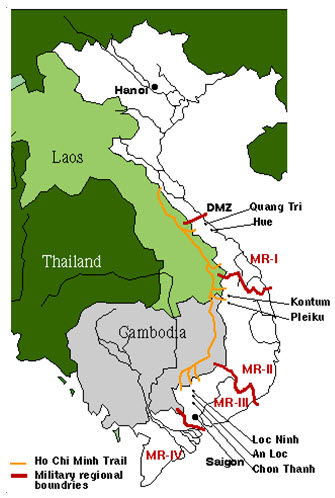
The 45 days following the start of the Easter Offensive saw the U.S. Navy respond with the carrier force building to six.
In April, during the height of the Communists’ Easter Offensive, the U.S. 7th Fleet’s Task Force 77 on Yankee Station was busy providing support of the hard-pressed ground forces. Cruisers and destroyers poured round after round from their 6- and 5-inch guns at the invading enemy divisions. On 3 April, Admiral McCain ordered USS Kitty Hawk CVA-63 and USS Constellation CV-64 to join them.
Six carriers – the USS Constellation, USS Kitty Hawk, USS Hancock, USS Coral Sea, USS Saratoga and the USS Midway – all joined in Operation Freedom Train. The cruiser USS Oklahoma City and three destroyers trained their guns on the Do Son Peninsula, a small strip of land guarding the approaches to Haiphong. The destroyers USS Joseph Strauss and USS Richard B. Anderson hit the Ben Hai Bridge in the northern section of the DMZ (Demilitarized Zone).
The U.S. naval forces still operating in support of the Market Time coastal surveillance patrol contributed to the allied defense as well. In April, P-3 Orion aircraft based in the Philippines helped South Vietnamese units detect and turn back three of four Communist trawlers sent south. A combined surface patrol force intercepted and sank the fourth ship.
Of even greater importance to the nationwide South Vietnamese defensive effort was the Navy's campaign against North Vietnam, where the enemy launched and supplied the Easter Offensive. On 2 April, soon after it became apparent that a major Communist effort was underway, President Nixon ordered his Pacific forces to strike that region of North Vietnam nearest to the DMZ by air and sea. By 9 May, the entire country, excluding a buffer zone 30 miles deep along the Chinese border and a number of sensitive targets, had been opened to Navy and Air Force attack.
During April, the first month of operations, the Seventh Fleet resumed the interdiction campaign that ended in November 1968. Task Force 77 swelled to include five carriers, Constellation, Kitty Hawk, Hancock, Coral Sea, and Saratoga (CVA 60). The addition of Midway to the task force in May would make this the largest concentration of carriers in the Gulf of Tonkin during the war. The air squadrons, massed for multi-aircraft strikes in Operation Freedom Train, hit key military and logistic facilities at Dong Hoi, Vinh, Thanh Hoa, Haiphong, and Hanoi. Smaller flights attacked enemy troop units, supply convoys, and headquarters in the areas around the DMZ.
Also taking part in Freedom Train were the fleet's gun cruisers and destroyers, which ranged the southern North Vietnamese coastline, shelling transportation routes, troop concentrations, shore defenses, and Communist logistic installations. USS Joseph Strauss DDG-16 and USS Richard B. Anderson DD-786 opened this renewed operation on 5 April when they fired on the Ben Hai Bridge in the northern half of the DMZ. Then on 16 April for the first time, cruiser Oklahoma City and three destroyers obliterated targets on the Do Son Peninsula, which guarded the approaches to Haiphong.
Quang Tri was evacuated 1 May.
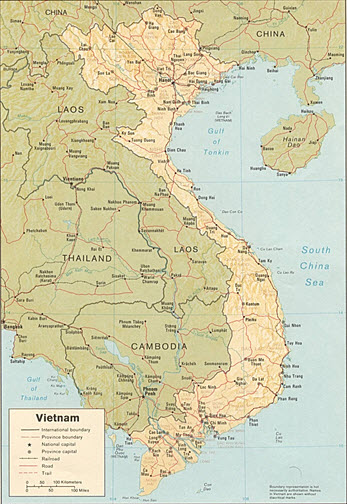
The North Vietnamese did not take the U.S. presence in the Gulf of Tonkin lightly, NVA shore batteries struck the destroyer USS Buchanan on 17 April 1972, killing one sailor and wounding seven others.
__________
Little did I know what my future would hold. I went back to Nebraska on annual leave from 17-26 January prior to our Goodwill Cruise (more or less the northern half of a South American Cruise) to Latin America, caring a Navy Band to perform for the people in each port of call. Great time! Go to 1972 Goodwill Cruise and check it out. Some pictures can be seen at Veracruz, Mexico Libery Call.
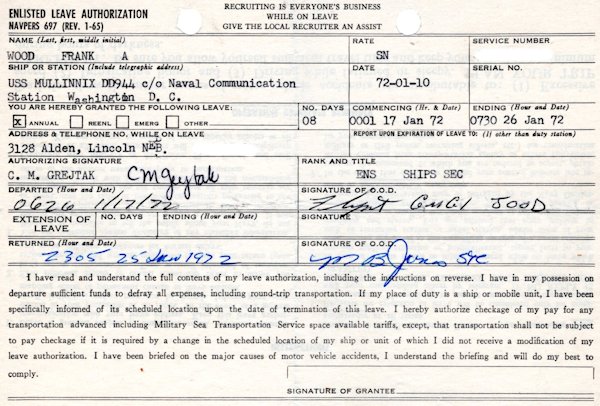
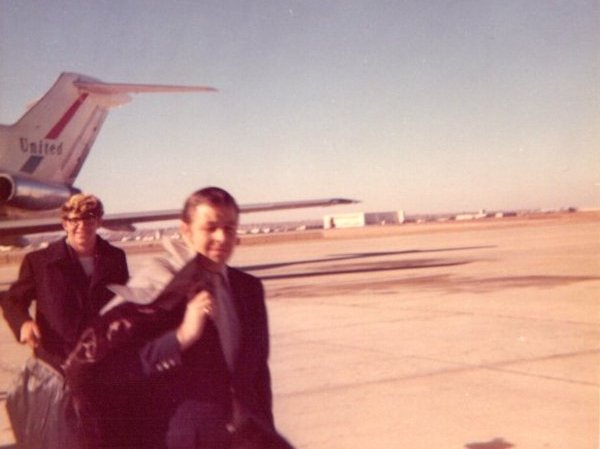
That's me, in uniform, getting of the United Flight in Lincoln, NE
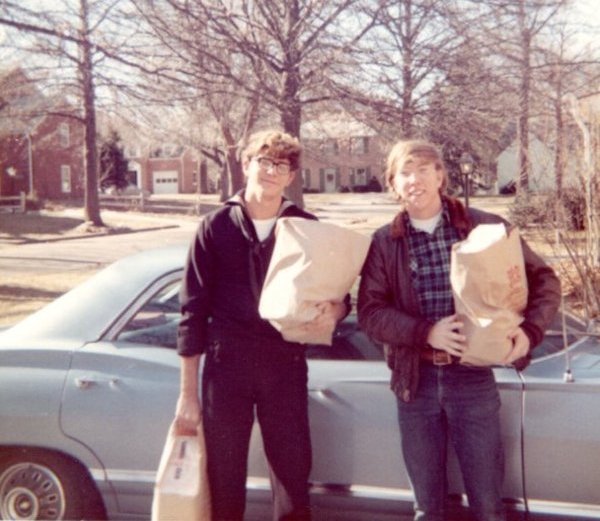
Me and my HS friend Larry Nord
We flunked out of Kearney State together, then joined the Navy together
Yes, those are both "Admiral Zumwalt" approved Navy haircuts! LOL!!!
Unfortunately, Larry passed away at 50 years of age.
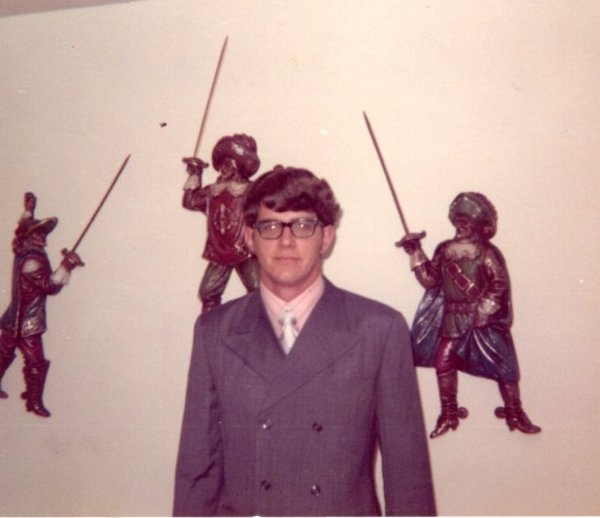
FTGSN Frank A. "Woody" Wood
I think I bought the 3 Musketeers for my folks in some liberty port
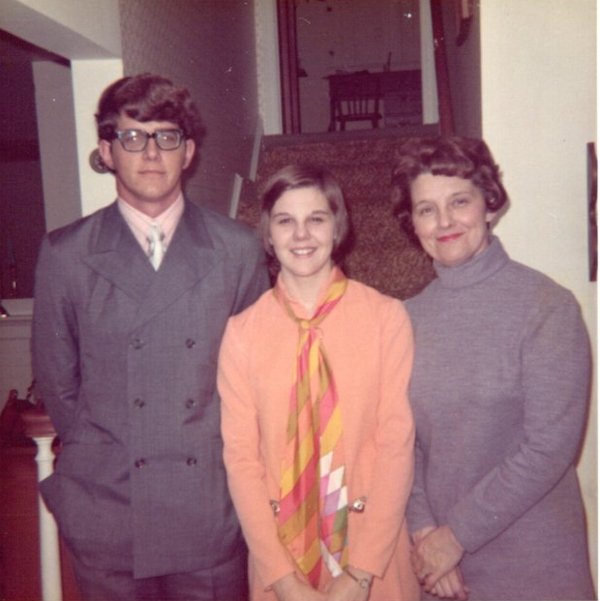
Me, my sister Sue, and my mom Marie Wood
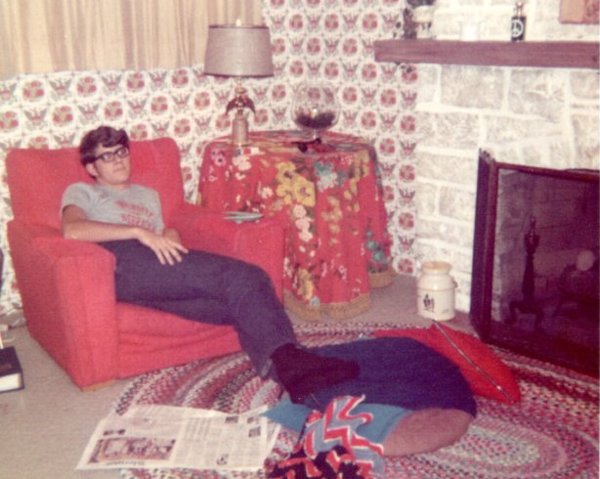
I look like I've been institutionalized, time to get back to the Mux?
__________
Once Mullinnix returned to Norfolk, the 'plan' was for the ship to be in drydock the rest of 1972. Many guys began making arrangements to move their families to the Norfolk area. This included my best friend, FTGSN Greg "Birdman" Berry from West "By God" Virginia. I actually took a couple days leave, coupled with a weekend, on 29 March - 1 April, to help 'The Birdman' move his wife and baby girl (I'm proud to be her God Father) to their apartment in Ocean View, Virginia.
The "orders" were cut on 8 April. I'll never forget: I had the duty. It was Saturday night and we were all in our (sleeping) compartment below MT52’s carrier room, watching TV on a rented TV that I’d rented at one of the clip-shops out on the strip. Us fire control guys and gunners’ mates shared the compartment with the radioman.
My good buddy, RM2 Neil “Jewels” Apple – yes, our Jewels was quite the jewel – was on call for any radio messages that might come in. Jewels gets called to the radio shack in the middle of one of our favorite TV shows to accept a message coming in. In the 70s there was no ‘pause’, so we said, “we’ll catch you up when you get back”.
30 minutes later Jewels comes back down to the apartment. Somebody pops of, “what’s going on, we going to Vietnam?” We all laughed…focusing on the TV.
Jewels paused, stoned face. “We’re leaving Monday morning.”
‘Cept for the TV noise, you could have heard a pin drop. Nobody spoke. What could you say? Finally, someone said, “You asshole, you’re fucking with us.”
“No, I’m not. Things are blowing up in Vietnam. They need our guns.”
Silence…
“Fuck me”, somebody finally murmurs…
Yeah, fuck us.
Rumors started hitting the Norfolk papers on 10 April and again on 11 April.
Mullinnix didn’t manage to leave Monday, but she sailed 2 days later on Wednesday, 12 April.
__________
Go to 8 April "Mullinnix Ordered to Gunline"
Back to 1972 Vietnam Gunline - Page 1
Back to Ship History
Home
© 2019 by Frank Wood, All rights reserved



 ullinnix participated in the campaign to defend Hue and the campaign to retake Quang Tri. These campaigns involved the largest assembly of gunfire support ships in the Vietnam War and the largest amphibious landing since Inchon and Wonsan in the Korean War. In support of Vietnamese Marines, U.S. ships fired 289,963 rounds, at the highest monthly rate since 1968.
ullinnix participated in the campaign to defend Hue and the campaign to retake Quang Tri. These campaigns involved the largest assembly of gunfire support ships in the Vietnam War and the largest amphibious landing since Inchon and Wonsan in the Korean War. In support of Vietnamese Marines, U.S. ships fired 289,963 rounds, at the highest monthly rate since 1968.







